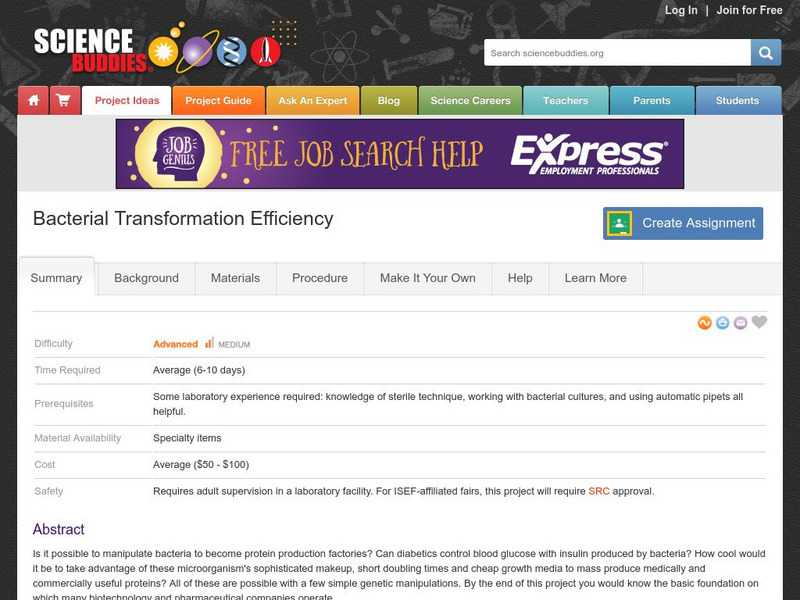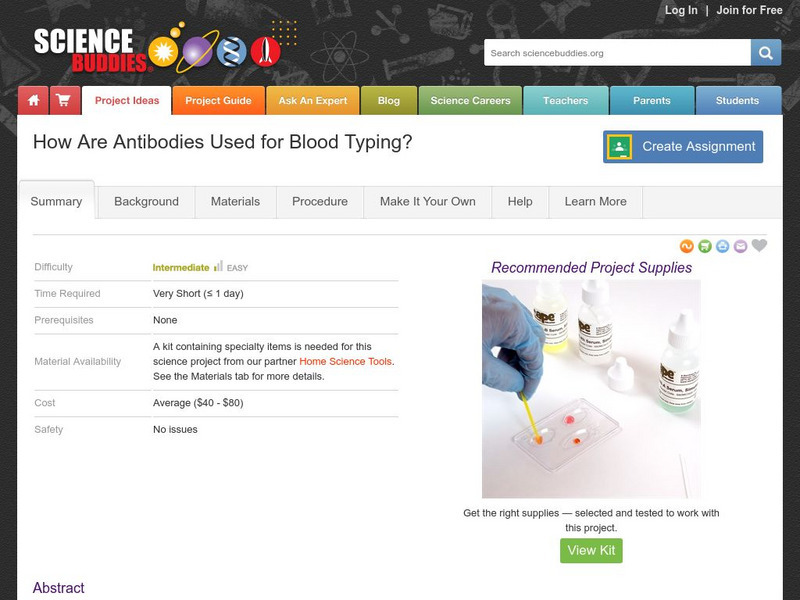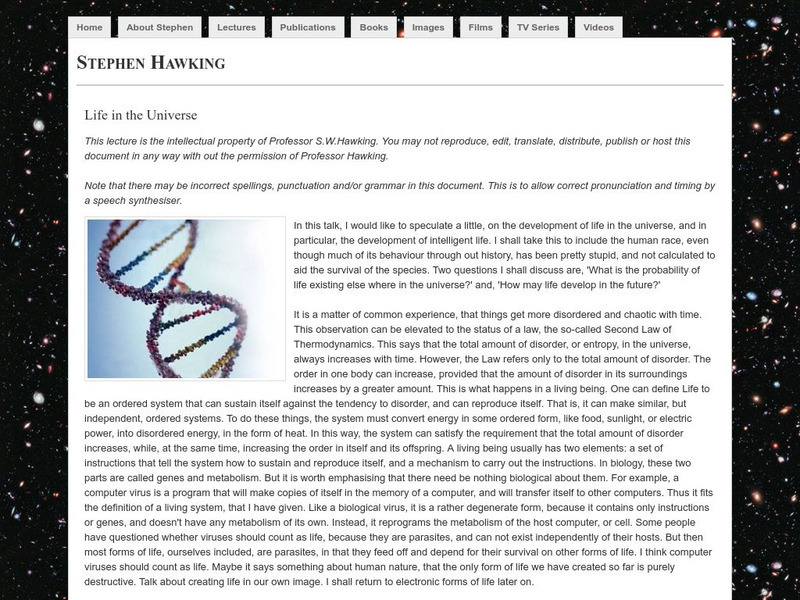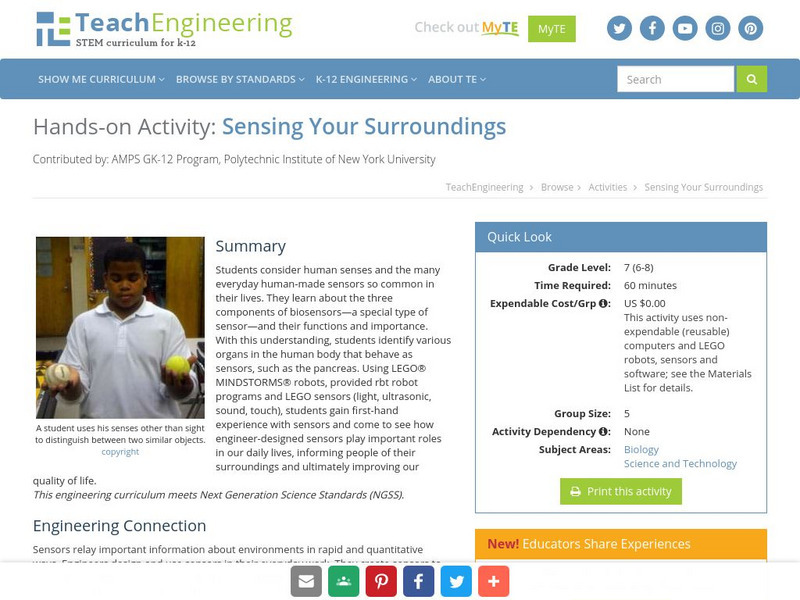Curated OER
DNA Replication
Students are able to distinguish between transcription and replication. They are able to distinguish between DNA and RNA. Students name some of the proteins and enzymes used in replication and transcription. They are able comprehend the...
Curated OER
Genetics and DNA
High schoolers describe the structure of DNA and its components and can comprehend that real DNA and its cartoon representation are very different. They are able to link DNA to genetic make-up.
Curated OER
Activity: Slinkies and Magnetic Fields
Your advanced physics class will appreciate this lesson in which they use magnetic field sensors to determine the relationship between the number of turns per meter of a solenoid and the magnetic field produced. The materials for this...
Curated OER
Teaching Bioethics
Use this guide for incorporating bioethics into your biology curriculum or for teaching a unit on the topic. A syllabus for an entire year is also available. The resource provides lists of online, video, and printed resources; however,...
Curated OER
Snappy Products
High schoolers explore genetics and biotechnology. Working in a group as a "biotech company", they genetically modify a plant and then promote their product at a biotechnology funding fair.
Curated OER
Who Wants to be a Health Care Worker?
A PowerPoint-based game, reminiscent of "Who Wants to Be a Millionaire?" introduces players to a wide range of health care professions. This resource is meant to be used as a career exploration activity for your high-schoolers.
Curated OER
Lesson 16: DNA Technology
Students research different areas of biotechnology. In this biology instructional activity, students create a presentation about their research. They debate the topic presented and share their views on the subject.
Curated OER
Biotechnology
In this biology worksheet, students complete a crossword puzzle with 23 questions on biotechnology. They identify the benefits and ethical issues about biotechnology.
Curated OER
Chemistry Far and Wide
In this chemistry worksheet, students fill in 10 blanks with the appropriate term, they determine if 4 statements are true or false, they match 6 terms with their definitions and they answer 3 questions. Topics include areas of chemistry...
Curated OER
Biotechnology: Changing Our Future
Students are introduced to the concept of biotechnology. In groups, they research its history and how scientists use it in their everyday experiments. As a class, they discuss how biotechnology might affect the future of scientists.
Curated OER
Biotechnology Projects and Writing Assignments
Students research a subject about biotechnology and do a project or a writing assignment on it. They can pick from a possible eighteen different projects and five different writing projects.
Curated OER
Food of the Future
Students combine their knowledge of genetics, farming and nutrition to design a genetically engineered food. Students focus on how the food will be improved, how it differs from the original product, what types of modifications will be...
Curated OER
Foods for Better Health
Students define biotechnology and discuss the economic impact of biotechnology. They also describe what a 1015 onion and a slow-softening tomato are and how they are produced. They examine the safety of genetically-engineered or altered...
Curated OER
Forensic Science - A Paternal Case
Ninth graders identify and relate terms in biotechnology. They discuss genetic engineering in the world today. Students are given a worksheet to determine the father in the paternal case. They complete answers on the worksheet.
Curated OER
Study Guide For Semester Exam
Students complete a study guide covering the basic materials for the final exam. They read through the study guide answering questions. Students read upcoming biotechnology section. They are asked if there any questions about the...
Curated OER
Sci-Fi/Biotech Video Worksheets
Students watch two commercial films which portray an historical perspective and possible uses of biotechnology in order to better understand the vocabulary and techniques involved in genetic engineering.
Science Buddies
Science Buddies: Extracting Onion Dna
In this project, you'll learn how to isolate DNA from onion cells, separating it from other cellular components in a manner that still preserves its structure and sequence. In the end, you'll have enough DNA to see with the unaided eye,...
Science Buddies
Science Buddies: Bacterial Transformation Efficiency
Is it possible to take advantage of microorganism's sophisticated makeup, short doubling times and cheap growth media to mass produce medically and commercially useful proteins? This is possible with a few simple genetic manipulations....
Science Buddies
Science Buddies: How Are Antibodies Used for Blood Typing?
The human immune system has various ways of responding to an infection caused by bacteria or viruses. Our bodies produce proteins (antibodies) that are highly specific for the infectious agent as a part of our "humoral" immune response....
American Institute of Biological Sciences
Action Bioscience: The Ecological Impacts of Agricultural Biotechnology
Discover some of the pros and cons of agricultural biotechnology.
Other
Stephen W. Hawking: Lectures: Life in the Universe
This lecture covers the topic of life now and into the future, including the role genetic engineering will play.
Georgetown University
Georgetown Univ.: Scope Note 24, Human Gene Therapy
Georgetown University site with a lengthy article on many aspects of gene therapy. Includes background and historical information and numerous resources on the topic. Focus here is on the ethics of these types of therapies.
TeachEngineering
Teach Engineering: Sensing Your Surroundings
Students learn about the components and functions of biosensors. Using LEGO MINDSTORMS NXT robots and sensors, they discover how engineer-designed sensors play important roles in our daily lives, informing people of their surroundings...
Science Buddies
Science Buddies: Solubility of Proteins
Some proteins are soluble in aqueous solutions and some are not. Insoluble proteins can be a problem because the proteins can form large aggregates in solution which are difficult to purify, crystallize, and use in experiments. Compare...

























